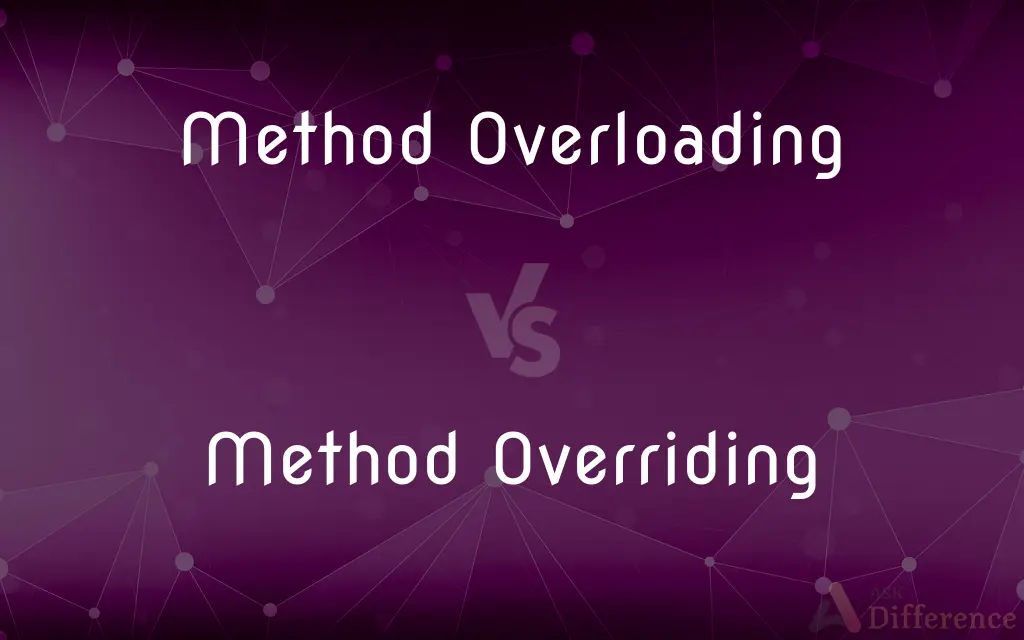Method Overloading vs. Method Overriding — What's the Difference?
By Maham Liaqat & Fiza Rafique — Published on March 28, 2024
Method Overloading allows multiple methods with the same name but different parameters, while Method Overriding involves redefining a parent class's method in a subclass.

Difference Between Method Overloading and Method Overriding
Table of Contents
ADVERTISEMENT
Key Differences
Method overloading occurs within a single class and allows the creation of multiple methods with the same name but different parameter lists. It's a way to increase the program's readability and reusability by allowing methods to perform similar but slightly different functions based on the inputs provided. Method overriding, on the other hand, occurs in the context of inheritance, where a subclass provides a specific implementation of a method that is already defined in its parent class. Overriding enables a subclass to offer a specialized behavior of a method that is more appropriate for the subclass, while still maintaining the method's signature consistent.
While method overloading is a compile-time polymorphism example, as the method to be called is determined at compile time based on the method signature, method overriding is an example of runtime polymorphism. The overridden method call to an object depends on the object's runtime type, not its compile-time type, which allows for dynamic method dispatch.
Moreover, method overloading enhances a class's ability to handle different data types and numbers of parameters, promoting functionality extension without changing existing code. Meanwhile, method overriding is fundamental for altering or extending a class's behavior inherited from a parent class, facilitating code reusability and improving code organization by keeping subclass-specific behaviors within the subclass itself.
Method overloading serves to offer multiple versions of a method differing in their input parameters within a single class, while method overriding allows a subclass to provide a specific implementation of a method that replaces one inherited from its parent class, underlining the versatility and flexibility of object-oriented programming.
Comparison Chart
Definition
Multiple methods in a class with the same name but different parameter lists
Subclass redefines its parent class's method
ADVERTISEMENT
Occurrence
Within the same class
Across parent and subclass
Purpose
To enhance readability and reusability by allowing similar but slightly different functions
To allow a subclass to provide a specific behavior of an inherited method
Compile-time/Runtime
Compile-time polymorphism
Runtime polymorphism
Parameter List
Must differ in number/type of parameters
Must be same as the method in the parent class
Return Type
Can vary
Must not change the return type, except for covariant return types
Usage
Handling different data types and numbers of parameters
Altering or extending the behavior of an inherited method
Example
CalculateArea(int radius) vs calculateArea(int length, int width)
Redefining draw() method in a subclass
Compare with Definitions
Method Overloading
Allows different methods for varying data types/quantities.
Add(int, int) and add(double, double).
Method Overriding
Allows subclasses to provide specific implementations of a method.
Implementing a displayInfo() method differently in each subclass.
Method Overloading
Enhances program readability and reusability.
Overloading a show method to display different types of data.
Method Overriding
Must not change the return type, except for covariant return types in certain languages like Java.
A clone method in a subclass returning an instance of its own type.
Method Overloading
Supports compile-time polymorphism.
The compiler determines which method version to call based on the parameter list at compile time.
Method Overriding
A subclass redefines a method from its parent class.
@Override void draw() in a subclass that extends a shape class.
Method Overloading
Defining multiple methods with the same name but different parameters.
Void print(String message) and void print(int number).
Method Overriding
Essential for runtime polymorphism and dynamic method dispatch.
Using a reference of a parent class to call a method of a subclass based on the object's runtime type.
Method Overloading
Provides the ability to offer more intuitive interface to users of the class.
Calculate method variations for different mathematical operations.
Method Overriding
Keeps the method's signature consistent while changing its behavior.
Redefining move() method for different types of game characters.
Common Curiosities
What is method overloading?
Method overloading involves defining multiple methods with the same name but different parameters in a class.
Why is method overriding important in inheritance?
It allows subclasses to modify or enhance the behavior of methods inherited from parent classes, enabling polymorphic behavior.
What ensures that a method is being overridden in a subclass?
In languages like Java, the @Override annotation can be used to indicate and ensure that a method is overridden, providing compile-time checking.
How does method overloading differ from method overriding in terms of polymorphism?
Method overloading is an example of compile-time (or static) polymorphism, whereas method overriding is an example of runtime (or dynamic) polymorphism.
Can the return type of an overridden method be changed?
Generally, the return type should not be changed in method overriding, except for covariant return types, where a subclass method returns a type derived from the return type of the overridden method.
What is method overriding?
Method overriding involves a subclass redefining a method that it inherits from its parent class.
What are the rules for method overriding?
The method in the subclass must have the same name, return type (or subtype, in the case of covariant return types), and parameter list as the method in the parent class. It must also respect the access level modifiers (the access level cannot be more restrictive than the overridden method's).
Can constructors be overridden or overloaded?
Constructors cannot be overridden as they are not inherited. However, constructors can be overloaded within the same class to allow the creation of objects in different ways.
Can method overloading and overriding be used together?
Yes, a class can use both method overloading and overriding to increase functionality and flexibility in object-oriented programming.
How does method overloading and overriding support software reuse?
Method overloading allows a class to handle different data types or numbers of inputs with methods that have the same logical purpose, enhancing the class's usability. Method overriding enables subclasses to tailor inherited behavior without altering the parent class, promoting code reuse and flexibility.
What happens if a subclass has a method with the same name as a method in the parent class, but different parameters?
This is neither overriding nor overloading in the context of the relationship between the two classes; it's simply a new method in the subclass. However, it can be considered overloading within the subclass itself if it follows the rules of method overloading.
Why is method overriding considered a cornerstone of polymorphism?
Method overriding enables polymorphism by allowing a subclass to provide a specific implementation of a method that can be called on a reference of the parent class type, allowing for dynamic dispatch and behavior that varies at runtime based on the object's actual class.
What are the rules for method overloading?
Methods must have the same name but different parameter lists (type, number, or both) within the same class. The return type can be different and is not considered part of the method signature for overloading purposes.
Can static methods be overridden?
No, static methods cannot be overridden because they are not dispatched at runtime. However, a static method in a subclass can have the same signature as a static method in the parent class, but this is not considered overriding; it's called hiding.
How do access modifiers affect method overriding?
The access level of an overridden method cannot be more restrictive than that of the method it overrides. For example, if the parent method is protected, the overriding method in the child class cannot be private.
Share Your Discovery

Previous Comparison
Mozzarella vs. Provolone
Next Comparison
Cash vs. CoinsAuthor Spotlight
Written by
Maham LiaqatCo-written by
Fiza RafiqueFiza Rafique is a skilled content writer at AskDifference.com, where she meticulously refines and enhances written pieces. Drawing from her vast editorial expertise, Fiza ensures clarity, accuracy, and precision in every article. Passionate about language, she continually seeks to elevate the quality of content for readers worldwide.
















































